Research Progress on Metal–Organic Framework-Based Electrode Materials for Supercapacitors
Abstract
:1. Introduction
2. Classification of Supercapacitors
3. Pure MOF Materials
4. MOF-Derived Materials
4.1. Porous Carbon Materials
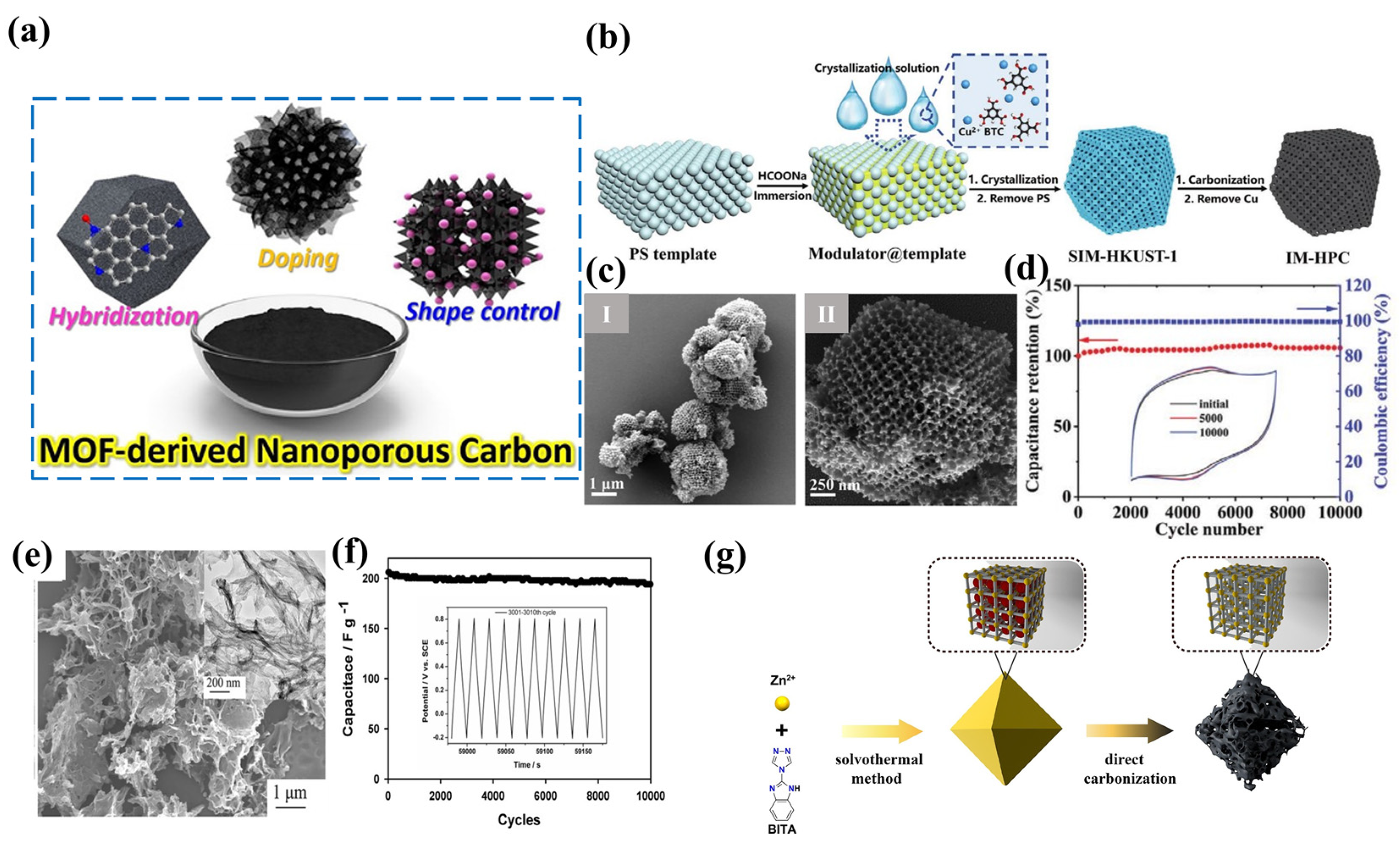
4.2. Transition Metal Oxide
4.3. Metal Hydroxides
5. MOF Composite Materials
5.1. MOFs and NonMetallic Materials
5.2. MOFs and Metallic Materials
6. Conclusions and Perspectives
- (1)
- Materials preparation of MOF. Currently, the majority of MOFs are produced in laboratories using techniques like hydrothermal, solvothermal synthesis, etc. However, these techniques may have some limitations including low yield, high energy consumption and time consuming. It prevents them from large-scale industrial production and practical applications. Moreover, some organic compounds and solvents for MOF preparation are toxic while the postprocessing is sometimes expensive. Therefore, to develop a green and effective organic ligand with recycling technology to reduce costs is significant.
- (2)
- High conductance and high capacitance. Most pure MOFs have large resistance and poor conductivity, which is disadvantageous for SCs, although some newly reported conductive MOFs such as Ni3(HITP)2 showcase potential practicability. However, the performance also relies on the electrodes, e.g., ionic liquid rather than being highly stable in aqueous acid or alkaline. The conjugated system can facilitate fast electron transport, yet the energy storage behavior is sometimes complicated and independent of pore sizes. Hence, to explore new types of MOFs with both excellent properties is still challenging.
- (3)
- The design of MOF-based SC devices. The device design can maximize the electrochemical performance of SCs and broaden the application scenarios. For example, similar to graphene-based devices, flexible microcapacitors with 2D MOFs grown in situ on the intercalation electrode can simultaneously satisfy powering unit and wearable requirements. In the future, there will be more integrated units based on MOFs. For instance, the pore nature of MOFs can be expanded to fabricate MOF gas sensors but being self-powered by MOF-based SCs.
- (4)
- Mechanism. Currently, the accurate mechanisms of electrochemical storage of MOFs are still ambiguous. The capacitive capacity and whether it belongs to faradaic pseudocapacitive or EDLC are depending on the electrolytes. Moreover, for binary and multimetallic MOFs, the mechanism of how different components influence electrochemical performance has not yet been figured out. Therefore, there is a long way to go to fully explore it.
- (5)
- Advanced characterizations. Cs-corrected TEM and in situ spectrum now can ascertain the specific atomic structural changes of metal oxide electrodes, especially in the research of catalysts and batteries. For MOFs applied in SCs, due to the stability and organic/inorganic features, the advanced characterizations are still lacking. Moreover, for highly crystalline MOFs, during charging and discharging, there may be lattice strain to induce capacitance attenuation. Nevertheless, it has seldom been reported, due to the limitations of advanced characterizations.
Author Contributions
Funding
Data Availability Statement
Acknowledgments
Conflicts of Interest
Appendix A
| Samples | Metal Sites | Electrolyte | Maximum Capacitance (F g−1) | Measured Current Density (A g−1) | Cycle Life | Ref |
|---|---|---|---|---|---|---|
| Co-LMOF | Co | 1 M KOH | 2474 | 1 | 94.3% after 2000 cycles | [30] |
| Co-MOF | Co | 5 M KOH | 2564 | 1 | 95.8% after 3000 cycles | [31] |
| Co-MOFs | Co | 3 M KOH | 958.1 | 2 | 92.3% after 3000 cycles | [32] |
| Co-BTC | Co | 1M NaOH | 657 | 0.5 | 81.4% after 3000 cycles | [33] |
| Co-MOF-74 | Co | 3 M KOH | 164.2 | 0.5 | 75% after 1500 cycles | [34] |
| Ni-MOF | Ni | 3 M KOH | 988 | 1.4 | 96.5% after 5000 cycles | [36] |
| Ni-MOF | Ni | 3 M KOH | 1057 | 1 | 70% after 2500 cycles | [37] |
| Ni/Co-MOF | Ni/Co | 2 M KOH | 758 | 1 | 75% after 5000 cycles | [39] |
| Ni/Co-MOF | Ni/Co | 2 M KOH | 2860 | 1 | 90% after 2000 cycles | [40] |
| MOF-5 | Zn | 6 M KOH | 300 | 1.5 | 91% after 3000 cycles | [52] |
| ZIF-8@ZnO | Zn | 1M H2SO4 | 290 | 1 | 94% after 10,000 cycles | [54] |
| NPMOF | Zn | 6 M KOH | 220 | 1 | 99.1% after 10,000 cycles | [55] |
| Co3O4@Co-MOF | Co | 3 M KOH | 1020 | 0.5 | 96.7% after 5000 cycles | [57] |
| Ni/Mn-MOF | Ni/Mn | 1 M KOH | 1387 | 1 | 80% after 6500 cycles | [59] |
| PCNFs | Ni | 3 M KOH | 1419 | 1 | 88.5% after 10,000 cycles | [61] |
| Ni-Co LDH | Ni/Co | 1 M NaOH | 2200 | 5 | 98.6% after 3000 cycles | [66] |
| Ce-MOF/GO | Ce | 3 M KOH | 2221.2 | 1 | 87% after 5000 cycles | [74] |
| CC/CoNi-MOF | Ni/Co | 1 M KOH | 846 | 1 | 96.5% after 10,000 cycles | [75] |
| Ni-BTC@GO | Ni | 3 M KOH | 1199 | 1 | 84.5% after 5000 cycles | [77] |
| Co-MOF@CoNiO2 | Co | 6 M KOH | 757.2 | 1 | 80.6% after 5000 cycles | [82] |
| Ni-MOF@Co(OH)2 | Ni | 1 M KOH | 1448 | 2 | 87.3% after 8000 cycles | [83] |
References
- Sanyal, S.; Wuebbles, D.J. The Potential Impact of a Clean Energy Society on Air Quality. Earths Future 2022, 10, e2021EF002558. [Google Scholar] [CrossRef]
- Xu, J.K.; Lei, J.F.; Ming, N.N.; Zhang, C.T.; Huo, K.F. Rational Design of Wood-Structured Thick Electrode for Electrochemical Energy Storage. Adv. Funct. Mater. 2022, 32, 2204426. [Google Scholar] [CrossRef]
- Roy, B.K.; Tahmid, I.; Rashid, T.U. Chitosan-based materials for supercapacitor applications: A review. J. Mater. Chem. A 2021, 9, 17592–17642. [Google Scholar] [CrossRef]
- Liu, Y.; Qian, J.L.; Shi, Y.X.; Xu, Y.; Mao, Y.J.; Lv, R.G.; Huang, B.; Sun, Y.Z.; Zhao, Z.Y.; Chang, Y.N.; et al. Latest advances of metal-organic frameworks-based materials for supercapacitors. Sustain. Mater. Technol. 2023, 36, e00588. [Google Scholar] [CrossRef]
- Fagiolari, L.; Sampo, M.; Lamberti, A.; Amici, J.; Francia, C.; Bodoardo, S.; Bella, F. Integrated energy conversion and storage devices: Interfacing solar cells, batteries and supercapacitors. Energy Storage Mater. 2022, 51, 400–434. [Google Scholar] [CrossRef]
- Shah, S.S.A.; Najam, T.B.; Bashir, M.S.; Peng, L.S.; Nazir, M.A.; Javed, M.S. Single-atom catalysts for next-generation rechargeable batteries and fuel cells. Energy Storage Mater. 2022, 45, 301–322. [Google Scholar] [CrossRef]
- Yang, Y.; Hoang, M.T.; Bhardwaj, A.; Wilhelm, M.; Mathur, S.; Wang, H.X. Perovskite solar cells based self-charging power packs: Fundamentals, applications and challenges. Nano Energy 2022, 94, 106910. [Google Scholar] [CrossRef]
- Li, X.; Wang, J. One-dimensional and two-dimensional synergized nanostructures for high-performing energy storage and conversion. Infomat 2020, 2, 3–32. [Google Scholar] [CrossRef]
- Ega, S.P.; Srinivasan, P. Quinone materials for supercapacitor: Current status, approaches, and future directions. J. Energy Storage 2022, 47, 103700. [Google Scholar] [CrossRef]
- Zhang, D.; Tan, C.; Zhang, W.Z.; Pan, W.J.; Wang, Q.; Li, L. Expanded Graphite-Based Materials for Supercapacitors: A Review. Molecules 2022, 27, 716. [Google Scholar] [CrossRef]
- Zhong, M.Z.; Zhang, M.; Li, X.F. Carbon nanomaterials and their composites for supercapacitors. Carbon Energy 2022, 4, 950–985. [Google Scholar] [CrossRef]
- Tang, Y.Q.; Shen, H.M.; Cheng, J.Q.; Liang, Z.B.; Qu, C.; Tabassum, H.; Zou, R.Q. Fabrication of Oxygen-Vacancy Abundant NiMn-Layered Double Hydroxides for Ultrahigh Capacity Supercapacitors. Adv. Funct. Mater. 2020, 30, 1908223. [Google Scholar] [CrossRef]
- Naseri, F.; Karimi, S.; Farjah, E.; Schaltz, E. Supercapacitor management system: A comprehensive review of modeling, estimation, balancing, and protection techniques. Renew. Sust. Energ. Rev. 2022, 155, 111913. [Google Scholar] [CrossRef]
- Zhao, Y.H.; He, X.Y.; Chen, R.R.; Liu, Q.; Liu, J.Y.; Yu, J.; Li, J.Q.; Zhang, H.S.; Dong, H.X.; Zhang, M.L.; et al. A flexible all-solid-state asymmetric supercapacitors based on hierarchical carbon cloth@CoMoO4NiCo layered double hydroxide core-shell heterostructures. Chem. Eng. J. 2018, 352, 29–38. [Google Scholar] [CrossRef]
- Sheberla, D.; Bachman, J.C.; Elias, J.S.; Sun, C.J.; Shao-Horn, Y.; Dinca, M. Conductive MOF electrodes for stable supercapacitors with high areal capacitance. Nat. Mater. 2017, 16, 220–224. [Google Scholar] [CrossRef]
- Zhou, H.C.; Kitagawa, S. Metal-Organic Frameworks (MOFs). Chem. Soc. Rev. 2014, 43, 5415–5418. [Google Scholar] [CrossRef]
- Liu, M.J.; Xing, Z.P.; Li, Z.Z.; Zhou, W. Recent advances in core-shell metal organic frame-based photocatalysts for solar energy conversion. Coord. Chem. Rev. 2021, 446, 214123. [Google Scholar] [CrossRef]
- Xu, B.; Zhang, H.B.; Mei, H.; Sun, D.F. Recent progress in metal-organic framework-based supercapacitor electrode materials. Coord. Chem. Rev. 2020, 420, 213438. [Google Scholar] [CrossRef]
- Xu, J.; Peng, Y.; Xing, W.Q.; Ding, Z.Y.; Zhang, S.T.; Pang, H. Metal-organic frameworks marry carbon: Booster for electrochemical energy storage. J. Energy Storage 2022, 53, 105104. [Google Scholar] [CrossRef]
- Zheng, S.Q.; Lim, S.S.; Foo, C.Y.; Haw, C.Y.; Chiu, W.S.; Chia, C.H.; Khiew, P.S. Recent Progress on the Applications of Carbonaceous and Metal-Organic Framework Nanomaterials for Supercapacitors. Front. Mater. 2021, 8, 777149. [Google Scholar] [CrossRef]
- Li, Q.; Xu, Y.X.; Zheng, S.S.; Guo, X.T.; Xue, H.G.; Pang, H. Recent Progress in Some Amorphous Materials for Supercapacitors. Small 2018, 14, 1800426. [Google Scholar] [CrossRef] [PubMed]
- Ajdari, F.B.; Kowsari, E.; Shahrak, M.N.; Ehsani, A.; Kiaei, Z.; Torkzaban, H.; Ershadi, M.; Eshkalak, S.K.; Haddadi-Asl, V.; Chinnappan, A.; et al. A review on the field patents and recent developments over the application of metal organic frameworks (MOFs) in supercapacitors. Coord. Chem. Rev. 2020, 422, 213441. [Google Scholar] [CrossRef]
- Fleischmann, S.; Mitchell, J.B.; Wang, R.C.; Zhan, C.; Jiang, D.E.; Presser, V.; Augustyn, V. Pseudocapacitance: From Fundamental Understanding to High Power Energy Storage Materials. Chem. Rev. 2020, 120, 6738–6782. [Google Scholar] [CrossRef] [PubMed]
- Tang, Y.Q.; Liang, Z.B.; Jin, Y.K.; Gao, S.; Zou, R.Q. Understanding and tackling lattice manganese exfoliation and deactivation of battery-type NiMn-LDH in fast electrochemical energy storage. J. Mater. Chem. A 2021, 9, 23286–23295. [Google Scholar] [CrossRef]
- Sun, Y.Z.; Liu, Y.; Han, Y.T.; Li, Z.Y.; Ning, G.Q.; Xing, R.; Ma, X.L. Effects of thermal transformation on graphene-like lamellar porous carbon and surface-contributed capacitance. Mater. Today Commun. 2021, 29, 102982. [Google Scholar] [CrossRef]
- Xu, B.Y.; Zheng, M.B.; Tang, H.; Chen, Z.X.; Chi, Y.; Wang, L.; Zhang, L.; Chen, Y.Y.; Pang, H. Iron oxide-based nanomaterials for supercapacitors. Nanotechnology 2019, 30, 204002. [Google Scholar] [CrossRef]
- Liu, Y.; Zhang, B.H.; Yang, Y.Q.; Chang, Z.; Wen, Z.B.; Wu, Y.P. Polypyrrole-coated alpha-MoO3 nanobelts with good electrochemical performance as anode materials for aqueous supercapacitors. J. Mater. Chem. A 2013, 1, 13582–13587. [Google Scholar] [CrossRef]
- Zhao, Y.H.; He, X.Y.; Chen, R.R.; Liu, Q.; Liu, J.Y.; Song, D.L.; Zhang, H.S.; Dong, H.X.; Li, R.M.; Zhang, M.L.; et al. Hierarchical NiCo2S4@CoMoO4 core-shell heterostructures nanowire arrays as advanced electrodes for flexible all-solid-state asymmetric supercapacitors. Appl. Surf. Sci. 2018, 453, 73–82. [Google Scholar] [CrossRef]
- Díaz, R.; Orcajo, M.G.; Botas, J.A.; Calleja, G.; Palma, J. Co8-MOF-5 as electrode for supercapacitors. Mater. Lett. 2012, 68, 126–128. [Google Scholar] [CrossRef]
- Liu, X.; Shi, C.; Zhai, C.; Cheng, M.; Liu, Q.; Wang, G. Cobalt-Based Layered Metal-Organic Framework as an Ultrahigh Capacity Supercapacitor Electrode Material. ACS Appl. Mater. Interfaces 2016, 8, 4585–4591. [Google Scholar] [CrossRef]
- Yang, J.; Ma, Z.; Gao, W.; Wei, M. Layered Structural Co-Based MOF with Conductive Network Frames as a New Supercapacitor Electrode. Chemistry 2017, 23, 631–636. [Google Scholar] [CrossRef] [PubMed]
- Ramachandran, R.; Zhao, C.; Luo, D.; Wang, K.; Wang, F. Morphology-dependent electrochemical properties of cobalt-based metal organic frameworks for supercapacitor electrode materials. Electrochim. Acta 2018, 267, 170–180. [Google Scholar] [CrossRef]
- Zhang, H.; Wang, J.; Sun, Y.; Zhang, X.; Yang, H.; Lin, B. Wire spherical-shaped Co-MOF electrode materials for high-performance all-solid-state flexible asymmetric supercapacitor device. J. Alloys Compd. 2021, 879, 160423. [Google Scholar] [CrossRef]
- Wang, C.; Li, X.; Yang, W.; Xu, Y.; Pang, H. Solvent regulation strategy of Co-MOF-74 microflower for supercapacitors. Chin. Chem. Lett. 2021, 32, 2909–2913. [Google Scholar] [CrossRef]
- Jiao, Y.; Pei, J.; Yan, C.S.; Chen, D.H.; Hu, Y.Y.; Chen, G. Layered nickel metal-organic framework for high performance alkaline battery-supercapacitor hybrid devices. J. Mater. Chem. A 2016, 4, 13344–13351. [Google Scholar] [CrossRef]
- Yan, Y.; Gu, P.; Zheng, S.; Zheng, M.; Pang, H.; Xue, H. Facile synthesis of an accordion-like Ni-MOF superstructure for high-performance flexible supercapacitors. J. Mater. Chem. A 2016, 4, 19078–19085. [Google Scholar] [CrossRef]
- Du, P.; Dong, Y.; Liu, C.; Wei, W.; Liu, D.; Liu, P. Fabrication of hierarchical porous nickel based metal-organic framework (Ni-MOF) constructed with nanosheets as novel pseudo-capacitive material for asymmetric supercapacitor. J. Colloid Interface Sci. 2018, 518, 57–68. [Google Scholar] [CrossRef]
- Shen, W.; Guo, X.; Pang, H. Effect of Solvothermal Temperature on Morphology and Supercapacitor Performance of Ni-MOF. Molecules 2022, 27, 8226. [Google Scholar] [CrossRef]
- Gao, S.; Sui, Y.; Wei, F.; Qi, J.; Meng, Q.; Ren, Y.; He, Y. Dandelion-like nickel/cobalt metal-organic framework based electrode materials for high performance supercapacitors. J. Colloid Interface Sci. 2018, 531, 83–90. [Google Scholar] [CrossRef]
- Xu, X.; Yang, J.; Hong, Y.; Wang, J. Nitrate Precursor Driven High Performance Ni/Co-MOF Nanosheets for Supercapacitors. ACS Appl. Nano Mater. 2022, 5, 8382–8392. [Google Scholar] [CrossRef]
- Tang, X.R.; Li, N.; Pang, H. Metal-organic frameworks-derived metal phosphides for electrochemistry application. Green Energy Environ. 2022, 7, 636–661. [Google Scholar] [CrossRef]
- Jiang, G.S.; Osman, S.; Senthil, R.A.; Sun, Y.Z.; Tan, X.; Pan, J.Q. Hierarchically porous carbon derived from magnesium-based metal-organic frameworks as advanced active material for supercapacitor. J. Energy Storage 2022, 49, 104071. [Google Scholar] [CrossRef]
- Dai, Y.Y.; Liu, C.L.; Bai, Y.; Kong, Q.Q.; Pang, H. Framework materials for supercapacitors. Nanotechnol. Rev. 2022, 11, 1005–1046. [Google Scholar] [CrossRef]
- Xu, S.J.; Dong, A.R.; Hu, Y.; Yang, Z.; Huang, S.M.; Qian, J.J. Multidimensional MOF-derived carbon nanomaterials for multifunctional applications. J. Mater. Chem. A 2023, 11, 9721–9747. [Google Scholar] [CrossRef]
- Cao, Z.W.; Momen, R.; Tao, S.S.; Xiong, D.Y.; Song, Z.R.; Xiao, X.H.; Deng, W.T.; Hou, H.S.; Yasar, S.; Altin, S.; et al. Metal-Organic Framework Materials for Electrochemical Supercapacitors. Nano-Micro Lett. 2022, 14, 181. [Google Scholar] [CrossRef]
- Kim, M.; Xin, R.J.; Earnshaw, J.; Tang, J.; Hill, J.P.; Ashok, A.; Nanjundan, A.K.; Kim, J.; Young, C.; Sugahara, Y.; et al. MOF-derived nanoporous carbons with diverse tunable nanoarchitectures. Nat. Protoc. 2022, 17, 2990–3027. [Google Scholar] [CrossRef]
- Zhang, L.Y.; Wang, R.; Chai, W.C.; Ma, M.Y.; Li, L.K. Controllable Preparation of a N-Doped Hierarchical Porous Carbon Framework Derived from ZIF-8 for Highly Efficient Capacitive Deionization. ACS Appl. Mater. Interfaces 2023, 15, 48800–48809. [Google Scholar] [CrossRef]
- Marpaung, F.; Kim, M.; Khan, J.H.; Konstantinov, K.; Yamauchi, Y.; Hossain, M.S.A.; Na, J.; Kim, J. Metal-Organic Framework (MOF)-Derived Nanoporous Carbon Materials. Chem. Asian J. 2019, 14, 1331–1343. [Google Scholar] [CrossRef]
- Salunkhe, R.R.; Kaneti, Y.V.; Kim, J.; Kim, J.H.; Yamauchi, Y. Nanoarchitectures for Metal-Organic Framework-Derived Nanoporous Carbons toward Supercapacitor Applications. Acc. Chem. Res. 2016, 49, 2796–2806. [Google Scholar] [CrossRef]
- Rajak, R.; Kumar, R.; Ansari, S.N.; Saraf, M.; Mobin, S.M. Recent highlights and future prospects on mixed-metal MOFs as emerging supercapacitor candidates. Dalton Trans. 2020, 49, 11792–11818. [Google Scholar] [CrossRef]
- Kumar, N.; Wani, T.A.; Pathak, P.K.; Bera, A.; Salunkhe, R.R. Multifunctional nanoarchitectured porous carbon for solar steam generation and supercapacitor applications. Sustain. Energy Fuels 2022, 6, 1762–1769. [Google Scholar] [CrossRef]
- Khan, I.A.; Badshah, A.; Khan, I.; Zhao, D.; Nadeem, M.A. Soft-template carbonization approach of MOF-5 to mesoporous carbon nanospheres as excellent electrode materials for supercapacitor. Micropor. Mesopor. Mat. 2017, 253, 169–176. [Google Scholar] [CrossRef]
- Li, Q.; Dai, Z.; Wu, J.; Liu, W.; Di, T.; Jiang, R.; Zheng, X.; Wang, W.; Ji, X.; Li, P.; et al. Fabrication of Ordered Macro-Microporous Single-Crystalline MOF and Its Derivative Carbon Material for Supercapacitor. Adv. Energy Mater. 2020, 10, 1903750. [Google Scholar] [CrossRef]
- Huang, J.L.; Hao, F.; Zhang, X.H.; Chen, J.H. N-doped porous carbon sheets derived from ZIF-8: Preparation and their electrochemical capacitive properties. J. Electroanal. Chem. 2018, 810, 86–94. [Google Scholar] [CrossRef]
- Gu, Y.; Miao, L.; Yin, Y.; Liu, M.; Gan, L.; Li, L. Highly N/O co-doped ultramicroporous carbons derived from nonporous metal-organic framework for high performance supercapacitors. Chin. Chem. Lett. 2021, 32, 1491–1496. [Google Scholar] [CrossRef]
- Meng, F.; Fang, Z.; Li, Z.; Xu, W.; Wang, M.; Liu, Y.; Zhang, J.; Wang, W.; Zhao, D.; Guo, X. Porous Co3O4 materials prepared by solid-state thermolysis of a novel Co-MOF crystal and their superior energy storage performances for supercapacitors. J. Mater. Chem. A 2013, 1, 7235–7241. [Google Scholar] [CrossRef]
- Zheng, S.; Li, Q.; Xue, H.; Pang, H.; Xu, Q. A highly alkaline-stable metal oxide@metal-organic framework composite for high-performance electrochemical energy storage. Natl. Sci. Rev. 2020, 7, 305–314. [Google Scholar] [CrossRef]
- Wu, M.-S.; Xu, J.-X. Nickel-cobalt oxide nanocages derived from cobalt-organic frameworks as electrode materials for electrochemical energy storage with redox electrolyte. Electrochim. Acta 2019, 319, 31–40. [Google Scholar] [CrossRef]
- Babu, S.K.; Raj, J.J.D.; Vijayakumar, T.; Gunasekaran, B. Experimental and DFT studies on spinel NiMn2O4 flower derived from bimetallic MOF as an efficient electrode for next-generation supercapacitor. Colloids Surf. A Physicochem. Eng. Asp. 2022, 655, 130244. [Google Scholar] [CrossRef]
- Lim, G.J.H.; Liu, X.; Guan, C.; Wang, J. Co/Zn bimetallic oxides derived from metal organic frameworks for high performance electrochemical energy storage. Electrochim. Acta 2018, 291, 177–187. [Google Scholar] [CrossRef]
- Acharya, D.; Pathak, I.; Dahal, B.; Lohani, P.C.; Bhattarai, R.M.; Muthurasu, A.; Kim, T.; Ko, T.H.; Chhetri, K.; Kim, H.Y. Immoderate nanoarchitectures of bimetallic MOF derived Ni–Fe–O/NPC on porous carbon nanofibers as freestanding electrode for asymmetric supercapacitors. Carbon 2023, 201, 12–23. [Google Scholar] [CrossRef]
- Feng, Y.; Yao, J.F. Tailoring the structure and function of metal organic framework by chemical etching for diverse applications. Coord. Chem. Rev. 2022, 470, 214699. [Google Scholar] [CrossRef]
- Shao, M.F.; Zhang, R.K.; Li, Z.H.; Wei, M.; Evans, D.G.; Duan, X. Layered double hydroxides toward electrochemical energy storage and conversion: Design, synthesis and applications. Chem. Commun. 2015, 51, 15880–15893. [Google Scholar] [CrossRef] [PubMed]
- Cao, F.; Gan, M.; Ma, L.; Li, X.; Yan, F.; Ye, M.; Zhai, Y.; Zhou, Y. Hierarchical sheet-like Ni-Co layered double hydroxide derived from a MOF template for high-performance supercapacitors. Synth. Met. 2017, 234, 154–160. [Google Scholar] [CrossRef]
- Huang, B.; Wang, W.; Pu, T.; Li, J.; Zhu, J.; Zhao, C.; Xie, L.; Chen, L. Two-dimensional porous (Co, Ni)-based monometallic hydroxides and bimetallic layered double hydroxides thin sheets with honeycomb-like nanostructure as positive electrode for high-performance hybrid supercapacitors. J. Colloid Interface Sci. 2018, 532, 630–640. [Google Scholar] [CrossRef]
- Liu, Y.; Fu, N.; Zhang, G.; Xu, M.; Lu, W.; Zhou, L.; Huang, H. Design of Hierarchical Ni-Co@Ni-Co Layered Double Hydroxide Core-Shell Structured Nanotube Array for High-Performance Flexible All-Solid-State Battery-Type Supercapacitors. Adv. Funct. Mater. 2017, 27, 1605307. [Google Scholar] [CrossRef]
- Wang, X.K.; Hao, C.; Zhang, J.S.; Ni, C.H.; Wang, X.H.; Shen, Y.T. Reasonable design and synthesis of nickel manganese sulfide nanoparticles derived from metal organic frameworks as electrode materials for supercapacitors. J. Power Sources 2022, 539, 231594. [Google Scholar] [CrossRef]
- Li, S.S.; Yang, Y.; Hu, Z.B.; Li, S.; Ding, F.; Xiao, X.X.; Si, P.C.; Ulstrup, J. Hetero-structured NiS/CoS nanospheres embedded on N/S co-doped carbon nanocages with ultra-thin nanosheets for hybrid supercapacitors. Electrochim. Acta 2022, 424, 140604. [Google Scholar] [CrossRef]
- Li, C.Y.; Wang, J.; Yan, Y.; Huo, P.W.; Wang, X.K. MOF-derived NiZnCo-P nano-array for asymmetric supercapacitor. Chem. Eng. J. 2022, 446, 137108. [Google Scholar] [CrossRef]
- Sun, L.; Liu, Y.; Yan, M.; Yang, Q.J.; Liu, X.Y.; Shi, W.D. Lewis acid etched NixCo1-xSe2 derived from ZIF-L on CoO nanowires for hybrid-supercapacitors. Chem. Eng. J. 2022, 431, 133472. [Google Scholar] [CrossRef]
- Lu, X.F.; Xia, B.Y.; Zang, S.Q.; Lou, X.W. Metal-Organic Frameworks Based Electrocatalysts for the Oxygen Reduction Reaction. Angew. Chem. Int. Ed. 2020, 59, 4634–4650. [Google Scholar] [CrossRef]
- Yang, B.L.; Li, B.J.; Xiang, Z.H. Advanced MOF-based electrode materials for supercapacitors and electrocatalytic oxygen reduction. Nano Res. 2022, 16, 1338–1361. [Google Scholar] [CrossRef]
- Hosseinian, A.; Amjad, A.; Hosseinzadeh-Khanmiri, R.; Ghorbani-Kalhor, E.; Babazadeh, M.; Vessally, E. Nanocomposite of ZIF-67 metal-organic framework with reduced graphene oxide nanosheets for high-performance supercapacitor applications. J. Mater. Sci. Mater. Electron. 2017, 28, 18040–18048. [Google Scholar] [CrossRef]
- Ramachandran, R.; Xuan, W.L.; Zhao, C.H.; Leng, X.H.; Sun, D.Z.; Luo, D.; Wang, F. Enhanced electrochemical properties of cerium metal-organic framework based composite electrodes for high-performance supercapacitor application. RSC Adv. 2018, 8, 3462–3469. [Google Scholar] [CrossRef] [PubMed]
- Xu, S.; Liu, R.; Shi, X.; Ma, Y.; Hong, M.; Chen, X.; Wang, T.; Li, F.; Hu, N.; Yang, Z. A dual CoNi MOF nanosheet/nanotube assembled on carbon cloth for high performance hybrid supercapacitors. Electrochim. Acta 2020, 342, 136124. [Google Scholar] [CrossRef]
- Ibrahim, I.; Zheng, S.; Foo, C.Y.; Huang, N.M.; Lim, H.N. Hierarchical nickel-based metal-organic framework/graphene oxide incorporated graphene nanoplatelet electrode with exceptional cycling stability for coin cell and pouch cell supercapacitors. J. Energy Storage 2021, 43, 103304. [Google Scholar] [CrossRef]
- Chen, T.; Shen, T.; Wang, Y.; Yu, Z.; Zhang, W.; Zhang, Y.; Ouyang, Z.; Cai, Q.; Ji, Y.; Wang, S. In Situ Synthesis of Ni-BTC Metal–Organic Framework@Graphene Oxide Composites for High-Performance Supercapacitor Electrodes. ACS Omega 2023, 8, 10888–10898. [Google Scholar] [CrossRef]
- Shao, L.; Wang, Q.; Ma, Z.; Ji, Z.; Wang, X.; Song, D.; Liu, Y.; Wang, N. A high-capacitance flexible solid-state supercapacitor based on polyaniline and Metal-Organic Framework (UiO-66) composites. J. Power Sources 2018, 379, 350–361. [Google Scholar] [CrossRef]
- Xu, M.; Wang, X.; Ouyang, K.; Xu, Z. Two-Dimensional Metal-Organic Framework Nanosheets Grown on Carbon Fiber Paper Interwoven with Polyaniline as an Electrode for Supercapacitors. Energy Fuels 2021, 35, 19818–19826. [Google Scholar] [CrossRef]
- Ramandi, S.; Entezari, M.H. Design of new, efficient, and suitable electrode material through interconnection of ZIF-67 by polyaniline nanotube on graphene flakes for supercapacitors. J. Power Sources 2022, 538, 231588. [Google Scholar] [CrossRef]
- Hussain, I.; Iqbal, S.; Hussain, T.; Cheung, W.L.; Khan, S.A.; Zhou, J.; Ahmad, M.; Khan, S.A.; Lamiel, C.; Imran, M.; et al. Zn-Co-MOF on solution-free CuO nanowires for flexible hybrid energy storage devices. Mater. Today Phys. 2022, 23, 100655. [Google Scholar] [CrossRef]
- Wang, L.; Jia, D.; Yue, L.; Zheng, K.; Zhang, A.; Jia, Q.; Liu, J. In Situ Fabrication of a Uniform Co-MOF Shell Coordinated with CoNiO2 to Enhance the Energy Storage Capability of NiCo-LDH via Vapor-Phase Growth. ACS Appl. Mater. Interfaces 2020, 12, 47526–47538. [Google Scholar] [CrossRef] [PubMed]
- Shi, X.; Deng, T.; Zhu, G. Vertically oriented Ni-MOF@Co(OH)2 flakes towards enhanced hybrid supercapacitior performance. J. Colloid Interf. Sci. 2021, 593, 214–221. [Google Scholar] [CrossRef]
- Lu, J.; Duan, H.; Zhang, Y.; Zhang, G.; Chen, Z.; Song, Y.; Zhu, R.; Pang, H. Directional Growth of Conductive Metal-Organic Framework Nanoarrays along [001] on Metal Hydroxides for Aqueous Asymmetric Supercapacitors. ACS Appl. Mater. Interfaces 2022, 14, 25878–25885. [Google Scholar] [CrossRef]
- Shin, S.-J.; Gittins, J.W.; Balhatchet, C.J.; Walsh, A.; Forse, A.C. Metal–Organic Framework Supercapacitors: Challenges and Opportunities. Adv. Funct. Mater. 2023, 2308497. [Google Scholar] [CrossRef]
- Wang, W.J.; Chen, D.; Li, F.Y.; Xiao, X.; Xu, Q. Metal-organic framework-based materials as platforms for energy applications. Chem 2023. [Google Scholar] [CrossRef]
- Savariraj, A.D.; Raj, C.J.; Kale, A.M.; Kim, B.C. Road Map for In Situ Grown Binder-Free MOFs and Their Derivatives as Freestanding Electrodes for Supercapacitors. Small 2023, 19, 2207713. [Google Scholar] [CrossRef]
- Xu, Y.X.; Li, Q.; Guo, X.T.; Zhang, S.T.; Li, W.T.; Pang, H. Metal organic frameworks and their composites for supercapacitor application. J. Energy Storage 2022, 56, 105819. [Google Scholar] [CrossRef]
- Lokhande, P.E.; Kulkarni, S.; Chakrabarti, S.; Pathan, H.M.; Sindhu, M.; Kumar, D.; Singh, J.; Kumar, A.; Mishra, Y.K.; Toncu, D.C.; et al. The progress and roadmap of metal-organic frameworks for high-performance supercapacitors. Coord. Chem. Rev. 2022, 473, 214771. [Google Scholar] [CrossRef]
- Zhang, H.H.; Gu, C.; Yao, M.S.; Kitagawa, S. Hybridization of Emerging Crystalline Porous Materials: Synthesis Dimensionality and Electrochemical Energy Storage Application. Adv. Energy Mater. 2022, 12, 2100321. [Google Scholar] [CrossRef]

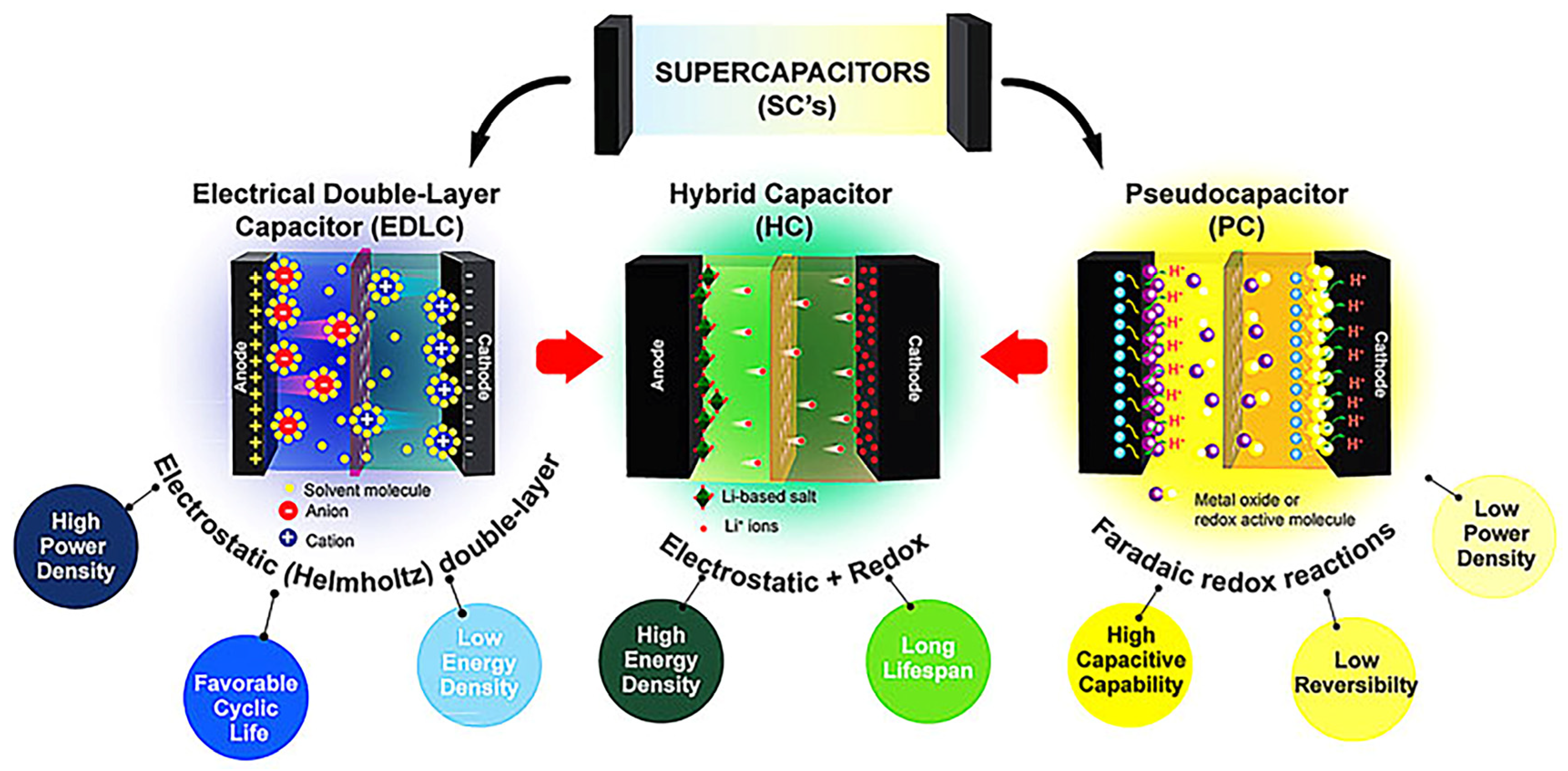


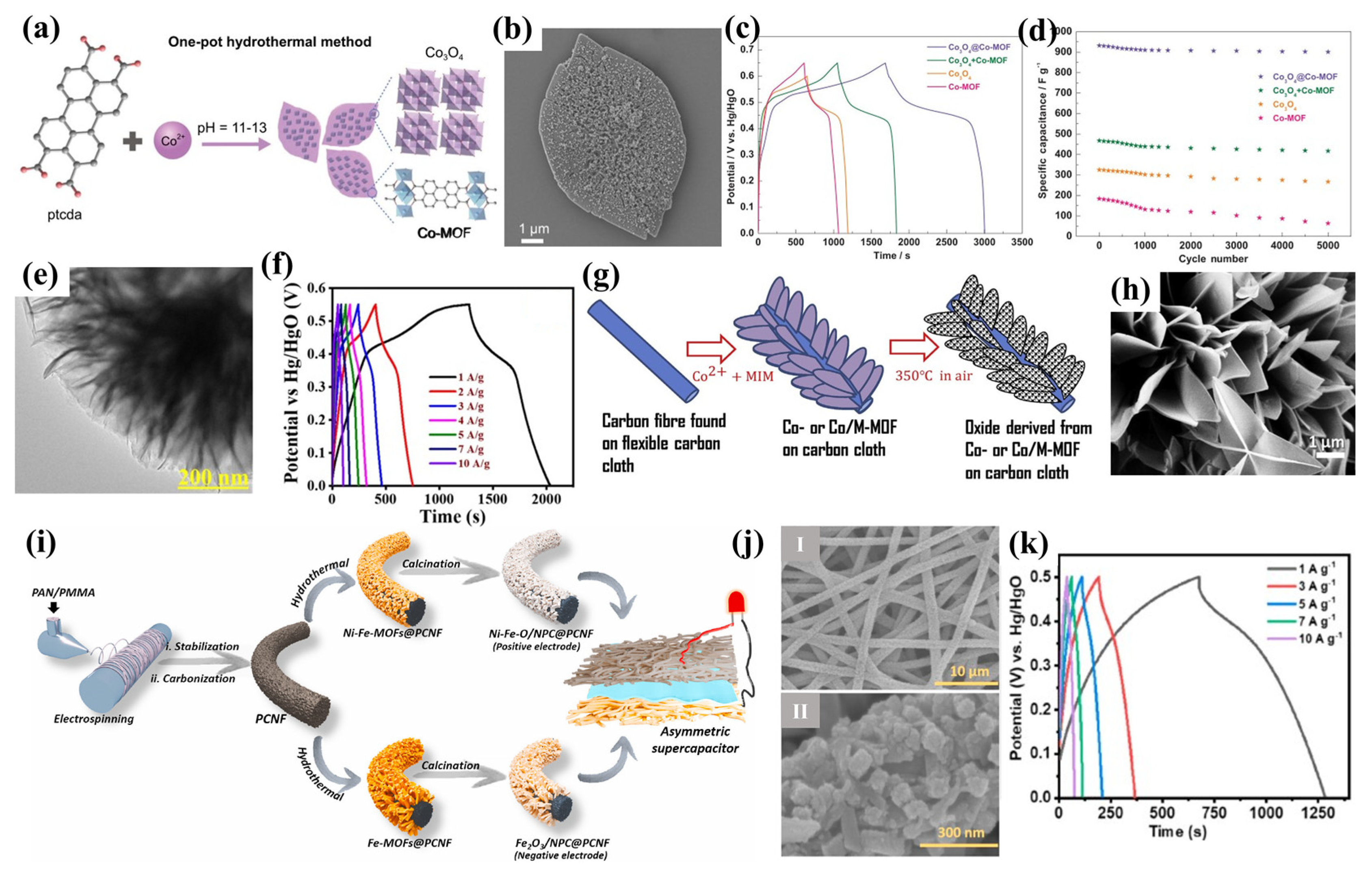
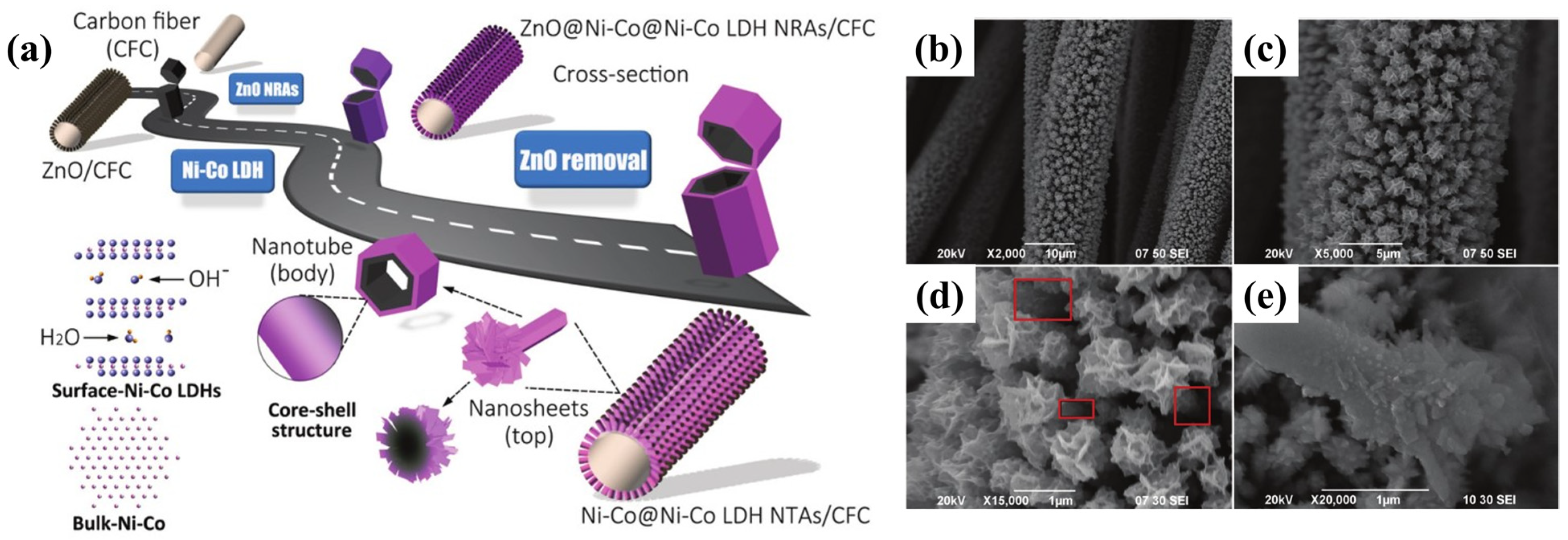
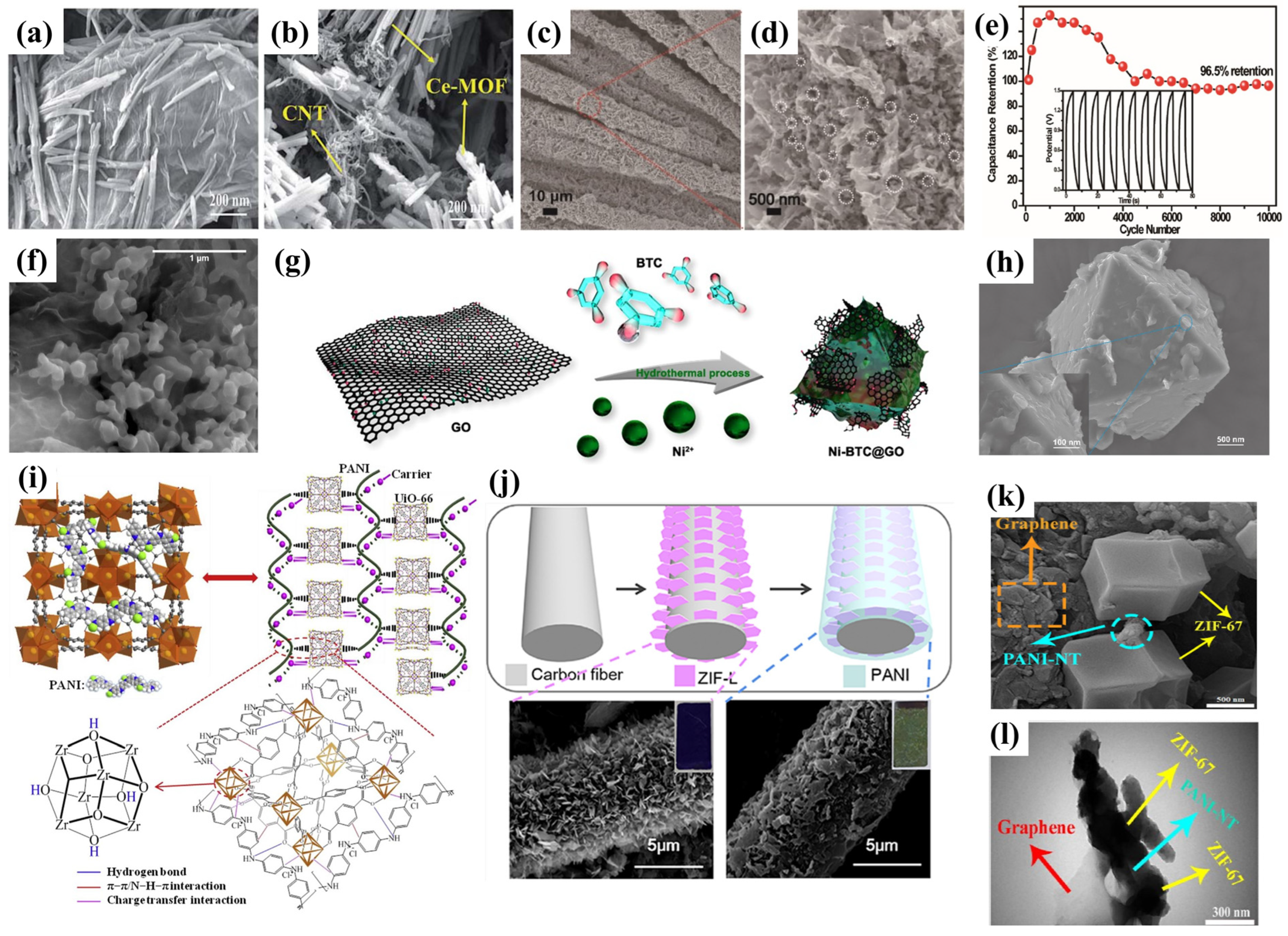
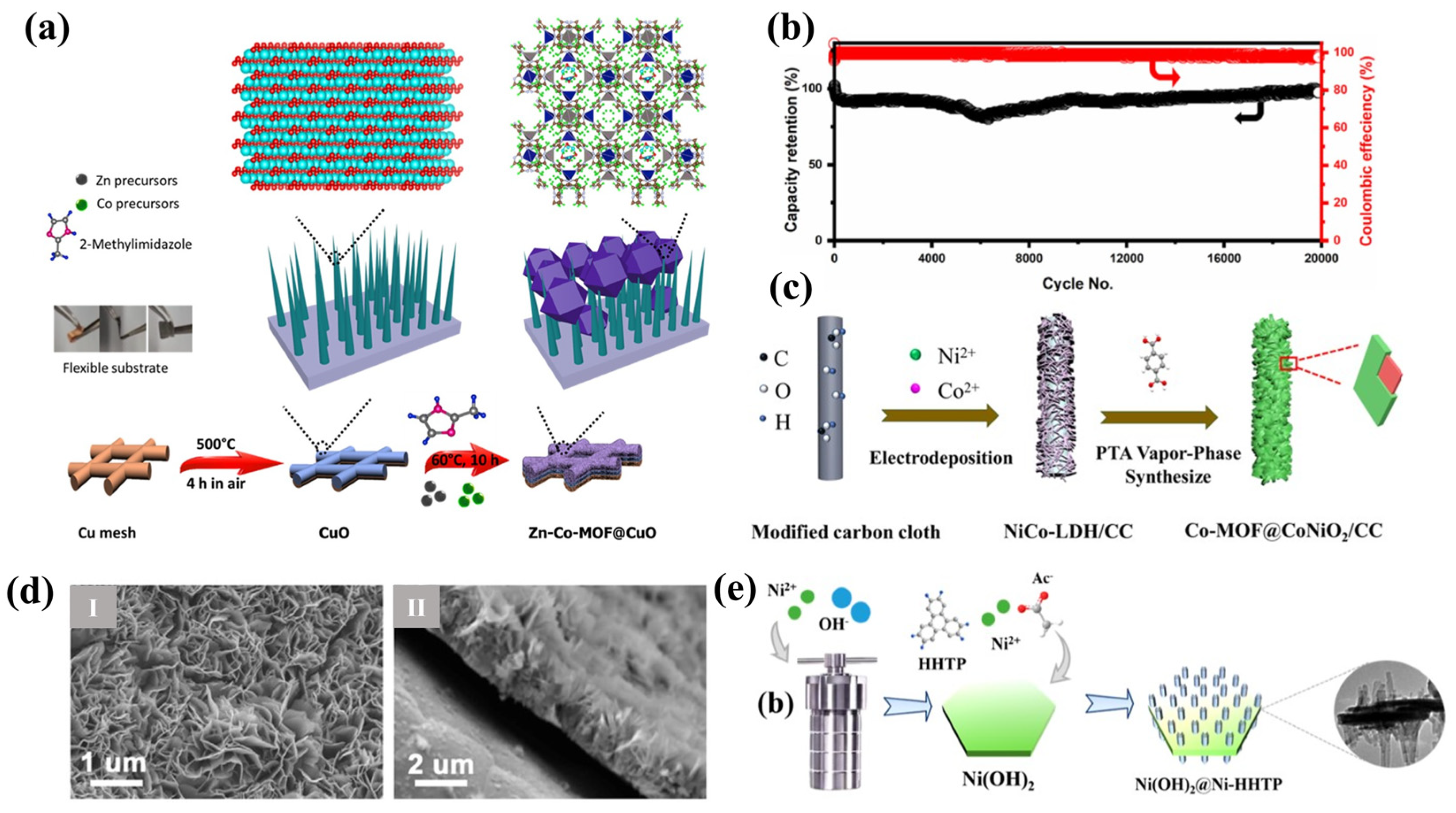
Disclaimer/Publisher’s Note: The statements, opinions and data contained in all publications are solely those of the individual author(s) and contributor(s) and not of MDPI and/or the editor(s). MDPI and/or the editor(s) disclaim responsibility for any injury to people or property resulting from any ideas, methods, instructions or products referred to in the content. |
© 2023 by the authors. Licensee MDPI, Basel, Switzerland. This article is an open access article distributed under the terms and conditions of the Creative Commons Attribution (CC BY) license (https://creativecommons.org/licenses/by/4.0/).
Share and Cite
Zhu, Y.; Su, P.; Wang, J.; Wang, X. Research Progress on Metal–Organic Framework-Based Electrode Materials for Supercapacitors. Crystals 2023, 13, 1593. https://doi.org/10.3390/cryst13111593
Zhu Y, Su P, Wang J, Wang X. Research Progress on Metal–Organic Framework-Based Electrode Materials for Supercapacitors. Crystals. 2023; 13(11):1593. https://doi.org/10.3390/cryst13111593
Chicago/Turabian StyleZhu, Yin, Peng Su, Jiemin Wang, and Xu Wang. 2023. "Research Progress on Metal–Organic Framework-Based Electrode Materials for Supercapacitors" Crystals 13, no. 11: 1593. https://doi.org/10.3390/cryst13111593





